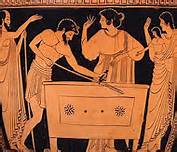In the ancient world, Sparta was famous for its piety. Individual Spartans could be granted leave
even from a campaign to take part in a religious festival, and on two famous
occasions recorded in Herodotus the entire Spartan army delayed deployment in
an emergency because of the need to “honor the gods.” (The deployment to
Marathon and Thermopylae).
But just what did “piety” or “honoring the gods” entail in
Ancient Greece? I admit, I find it difficult to understand this concept of “honoring”
fickle, unpredictable, immoral (as well as immortal) gods. And how could one
ever please all the different gods of the Greek pantheon when they were so
often at odds with one another? In a
polytheist world, honoring one god might offend another.
Yet in trying to understand Spartan society better, I
discovered some very interesting aspects of Spartan religion. First, Sparta’s patron was not, as I
expected, Ares, but rather Athena. On
reflection, this made sense since Sparta was not, as modern commentators would like
us to believe, a society obsessed exclusively with war, but a society which
placed as high a value on training the intellect as the body. (See the
excellent article by w. Lindsay Wheeler, “Doric Crete and Sparta, the home of
Greek Philosophy,” in Sparta: Journal of
Ancient Spartan and Greek History, Vol. 3, # 2). So giving pride of place
to Athena was understandable.
Even more fascinating was to discover how multi-faceted Spartan
religious beliefs were, and what an important place gods with positive
connotations – Apollo, Asclepius, Helios and even Aphrodite – played in Spartan
society. Nikolaos Kouloumpis in his article “The Worship and the role of
Religion in the formation of the Spartan state,” (Sparta: Journal of Ancient Spartan and Greek History, Vol. 6, #1) lists
cults to Asclepius, Achilles, Hercules, Alexandra/Cassandra, Agamemnon, Castor
and Pollux/ Polydeukes and Helios. And, of course, Sparta’s most important
festivals, the Karneia and Hyacinthia, were dedicated to Apollo. Even the Gymnopaedia, arguably the most famous
of Sparta’s annual festivals, was dedicated to Apollo and Artemis, Dionysus and Leto, while the more infamous than famous
festival of Artemis Orthia was, as the name implied, dedicated entirely to
Artemis. However, the cult of Menelaus
and Helen was only slightly less important, although we do not know how the
Eleneia was celebrated.
Turning from festivals to sanctuaries, Pausanias, in his
detailed guide to the “significant” sites of Sparta, records ten
temples/shrines to Athena, six to Zeus, and five to Aphrodite. The Devine Twins, Castor and Polydeukes,
Apollo, Artemis, and Poseidon and Asklepios all have four temples each. In contrast, there are only three temples out
of more than 150 temples, sanctuaries and shrines mentioned by Pausanias that
are dedicated to Ares. Two are notably located outside of Sparta proper, one in
Amyclae and the other even farther away in Geronthrai. The only temple to Ares in Sparta itself is
one in which the God of War is shown in chains, according to Pausanias because
“in Lakonia they think the god of war will never desert them if they keep him
in chains; [just as] in Athens they believe Victory will stay with them forever
because she has no wings.” (Pausanisus, Book III, 15:6).
While the large number of sanctuaries dedicated to Athena
and Zeus hardly need an explanation given their power and prominence in the
ancient Greek pantheon, it does seem odd that Aphrodite, Poseidon and Asklepios
should receive comparatively more honors than the god of war in land-locked, warlike
Sparta. Poseidon might be explained in
that he was also called the “Earth Shaker” and, given impact earthquakes had on
Lacedaemon, the Earth Shaker was clearly a god to be appeased. Notably one of Sparta’s temples to Poseidon
is to the “Horse-Breeding” Posiedon, and so a reflection of Sparta’s interest
and success in equestrian sports.
But why do Aphrodite and Asclepius place ahead of Ares in
terms of the number of sites dedicated to them? One possible explanation would
be the association of Aphrodite with Kythera, which was part of Lacedaemon for
the better part of 500 years. Allegedly,
the worship of Aphrodite originated on Kythera, and conceivably the cult spread
from there to the mainland of Lacedaemon.
However, it is notable that to date the only temple from the Classical
period to have been identified on Kythera was dedicated not to Aphrodite but to
Asclepius. (Again!) Possibly the worship
of the God of Healing also moved from Kythera to Sparta. Alternatively, the need to treat battle
injuries fostered a particular reverence for Asclepius. Such an interpretation
and the fact that there appear to have been more temples to Asclepius than Ares
suggests the Spartan’s trusted more to their own skills to win wars, than survive the aftermath.
In short, Sparta was filled with sanctuaries and temples to
a great diversity of gods, demi-gods and heroes. By no means was Spartan
worship narrowly focused upon the god of war, or even warrior heroes such as
Achilles. Instead, the heroes Heracles, Castor and Polydeukes, whose greatest
deeds were performed outside the context of war, receive more attention. This plethora of religious/cult focus in turn
suggests that Spartan society was far less narrow-minded and obsessed with
things military than most modern commentators imply.
Yet the essence of Spartan piety and how the Spartans related
to these various gods still eludes me. The
very diversity of god and demigods suggests, however, that there was no one Spartan religion or one Spartan way of worship. On the contrary, I suspect that each
Spartiate chose the god or gods he felt closest to and developed a highly
individualistic and private relationship with these deities. At the same time, Spartans publicly took part
in the seasonal rituals celebrated by the city for each of the gods in turn -- just
as many people do today.















